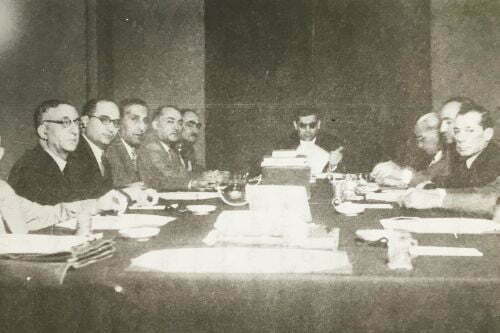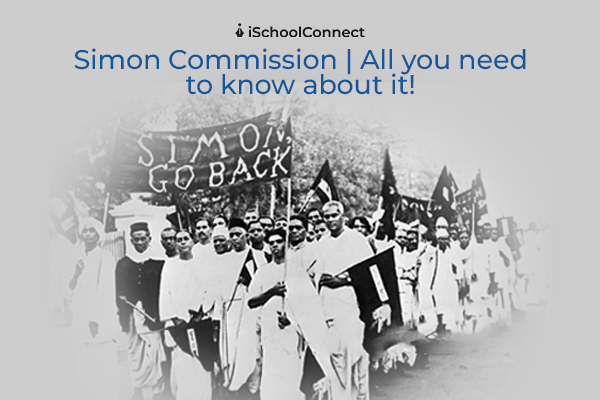Table of Contents
The name Simon Commission was after its chairman, Sir John Simon. The commission consisted of seven members (all British) and arrived in India in 1928. The Indian National Congress and most other Indian political parties boycotted the commission. It, nevertheless, published a two-volume report, mainly the work of Simon.
Arrival in India
The Simon Commission was in November 1927 under the chairmanship of Sir John Simon to report on the political situation in India. Some Indians called it ‘white man’s commission.’
Formation and members

The head of the Simon Commission was Sir John Simon, who became the British Foreign Secretary in 1929. It consisted of seven members—all British.
In 1928, the Commission came to India and was boycotted by Indians as a ‘white man’s commission’ since no Indians were allowed. The report includes some important proposals for constitutional reforms, but these faced rejections by Lord Irwin and his successor, Lord Willingdon, because they wanted an immediate transfer of power to Indians rather than gradual change over several years.
Recommendations
In May 1930, the Commission issued its two-volume report. The commission proposed abolishing the diarchy and extending provincial autonomy by establishing a representative government in each province. However, it allowed British governors of provinces to retain much of their emergency powers, implying that the provinces would have very little autonomy in practice. In particular, the commission’s report did not mention dominion status. The commission suggests to maintain separate electorates as long as inter-communal tensions between Hindus and Muslims persist.
Boycott
The commission was boycotted by the Indians, especially because no Indian was a part of it.
The Indians felt that the commission was not impartial. The Commission was headed by Sir John Simon, who had earlier served as Secretary of State for India and had been responsible for negotiating a settlement with the Indian leaders in 1930 at London’s Round Table Conference. Also, Lord Irwin (later Lord Halifax), who had been Viceroy of India from 1923-1931 and supported British rule in India, was one of its members. The commission did not consult the Indians. No invitation nor views on what form a federal government should take or how such a government should function.
‘White man’s commission’ and ‘Simon, go back.
The nationalists boycotted the commission who called it a ‘white man’s commission.’ They also gave a call, ‘Simon, go back.’
The Simon Commission was not accepted by the Indians and they were unhappy with its composition and methodology of work. The Commission failed to understand the demands of Indians and thus could not come up with a good solution for them to solve their problems amicably.
The Congress meeting with commission

The Congress formed an all-party committee comprising Gandhiji, Motilal Nehru, Vithalbhai Patel, Subhash Bose, and Jawaharlal Nehru to meet the Commission. The Committee had representatives from all parties that were opposed to partition, including Sardar Vallabhbhai Patel, Kailash Nath Katju, N.G. Ranga, and Shyamaprasad Mookerjee.
The Commission was headed by Sir John Simon, who was accompanied by three other members: William Bird Steinhardt (an American lawyer), Gopalaswami Ayyangar (Indian law minister), and James Francis Byrnes (a senior US politician).
Aftermath
Motilal Nehru presented his Nehru Report in September 1928, before the release of the Commission’s report. It was presented in response to the Commission’s charge that Indians were unable to reach a constitutional consensus among themselves. This report recommends that India be granted dominion status with full internal autonomy.
India’s Viceroy On October 31, 1929, Lord Irwin issued a declaration in which he reinterpreted the 1917 declaration. He also requested a round-table discussion on the topic in London. Despite many London conservatives’ outrage, British policy remained unchanged because the promise was not kept.
The Simon Commission’s report led to the passage of the Government of India Act 1935, which called for proper government at the provincial level but not at the national level in India.
This serves as the foundation for many sections of the Indian Constitution. The first provincial elections were held in 1937, and Congress governments were returned in almost every province.
Clement Attlee ended up moving during his time on the Commission and supported the final report. By 1933, however, he made the argument that British rule was foreign to India and ineffectual in establishing and implementing the essential social and economic reforms to propel India forward.
He rose through the ranks to become the most supportive British leader of Indian independence (as a dominion), laying the foundations for his role as British Prime Minister in the 1947 Indian independence decision.
Key Takeaways
- The Simon Commission was established in 1927 under the chairmanship of Sir John Simon to report on the political situation in India.
- It consisted of seven members (all British) and visited India in 1928.
- The commission was boycotted by Indians who termed it a ‘white man’s commission’ and they gave a call, ‘Simon, go back.’
- The Congress formed an all-party committee comprising Gandhi, Motilal Nehru, Vithalbhai Patel, Subhash Bose, and Jawaharlal Nehru to meet this commission, which was led by Maulana Azad to negotiate with the Simon Commission but failed due to its intransigence toward Indian demands for self-government.
Was this blog informative? If so, please share your thoughts in the comments below. Click here to reach out to us for more information on the Simon Commision. We would be happy to assist you with your queries!
FAQs
Q1. Who coined the slogan ‘Simon Go Back’?
Answer – Yusuf Meherally, a lesser-known hero of India’s independence struggle, came up with the term ‘Simon Go Back.’
Q2. Who formed a statutory commission under Sir John Simon?
Answer – The new Tory government in Britain established a Statutory Commission led by Sir John Simon. The commission, established in response to the nationalist movement, was tasked with investigating the functioning of India’s constitutional system and making recommendations for changes.
Q3. Who was Sir John Simon?
Answer – Sir John Simon was an English pathologist, surgeon, and public health officer who lived from 10 October 1816 to 23 July 1904. From 1855 to 1876, he served as Her Majesty’s Government’s first Chief Medical Officer.






